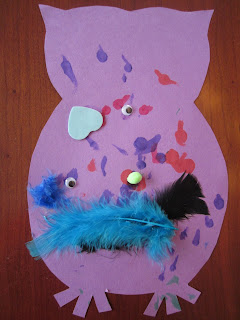Something clicked for Logan recently and his speech has really taken off! The list of new words and approximations that I have been making since his home teacher's last visit got so long that I was scribbling around the sides of the note paper and it was getting hard to keep track of his progress. I was incredibly excited to share this with Ms. Michelle today, especially since Ms. Pam, the speech pathologist came along on this visit. Last Tuesday, while he was at his LESA playgroup, he said three new approximations:
"bell," (while playing with play dough and seeing a bell shaped cookie cutter
) "eat," and
"drink" (During snack time of course, and he now consistently makes the
"k" sound for "drink," usually while signing "drink") and then when we got home he added
"moon" (He saw the moon.) and
"nummy" (for "yummy") to his repertoire.
And his vocabulary has just exploded since then! Last Thursday, he started saying
"bobby" for "baby" and I have heard him continue to say this when he sees a doll or picture of a baby. He also started saying
"bye bye" although now he has shortened it to "bye" while he pretends to talk on the phone or when we are leaving. Last Friday, he saw a toy dog and called it
"doggie" and later in the day he started saying
"heh-woh" for "hello" while pretending to talk on the phone. I can't tell you how long I have been waiting for him to start saying versions "hello" and "goodbye." This was bugging me a bit because it seemed like
every other kid (and usually much younger than Logan) was able to say them, so this is a big milestone for both of us.
On September 30, Logan peed in the potty for the first time. (Stick with me. I promise this is connected to his language development.) This was totally his idea, and I was pretty shocked that we was successful since he was just 25 months old. Then, when he went again a few minutes later, I called Brett and asked him to bring home some M&M's because it looked like we were potty training, whether we were ready for it or not. This has been a huge motivator for Logan and it has also increased his vocabulary because he really wants to earn those M&M's, or "nummies" as he calls them. He has gone potty at least once every day since then, and usually more like three or four times. Plus, he started asking to go
"potty" and telling me when he needs to go
"pee pee" (or has already gone in his diaper). Several times a day, he looks longingly at the pantry and declares
"nummy!" so I tell him he can earn a "nummy" by going potty. It's definitely working.
In the past few days, Logan has continued to add more new words and approximations to his vocabulary. This Tuesday at playgroup, he said something that sounded like
"puff" and something else that sounded very much like
"please" during snack time. On the way home, he saw a school bus and announced
"bus" or at least something that sounded a lot like "bus." Yesterday, while playing outside, he was concerned about the
"bug" on the slide and kept pointing it out and saying "bug" until I did got rid of it. He also asked me to fill his watering can by saying an approximation for
"water."
Logan was eating yogurt for breakfast this morning with a frog spoon and Brett reports that he pointed to the eye and said
"eye" and then he said
"froggy." During his home visit later in the morning, he said several new words while he helped Ms. Pam read
Brown Bear Brown Bear What Do You See? by choosing the correct animal magnet and putting it on the magnet board each time a new animal was introduced. He called out
"bear," "bird," "blue,"and
"duck."
During our session, Ms. Pam had me circle words/approximations that Logan has said from a list of common words that kids first learn and when she totaled up the list she said he knew 31 words. And we can now add "hockey" to the word list, too. He kept throwing a puck around this afternoon while yelling "hockey!" He is definitely all boy. We don't play or watch a lot of hockey, so why he would even have that as one of his first words is beyond me. Ms. Pam said our "homework" is to get him to start adding verbs to his vocabulary and then connecting them with the nouns he knows. I am hoping that this will be easy for my very active little guy.






































